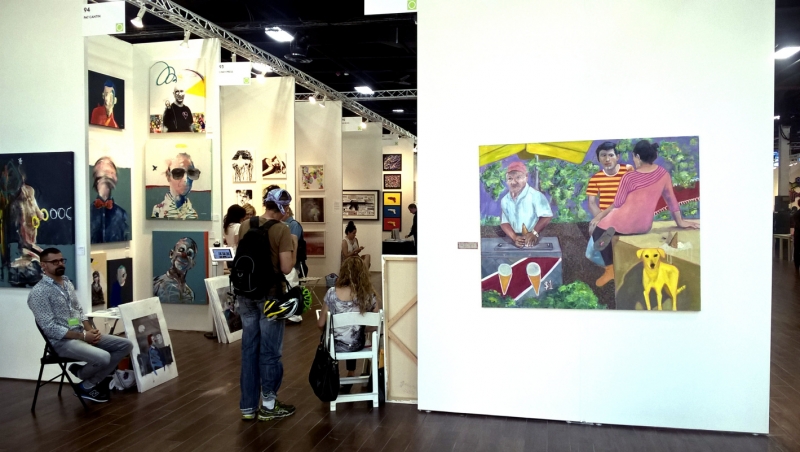A new art season, a new test of survival
Now that the new art season has begun, one question on everyone’s mind is: How many more galleries will close by next summer? In the past five years, notices of galleries shutting their doors have become as commonplace as announcements of new exhibitions. According to The Art Market 2018, a report on the market’s current state published by Art Basel and UBS, in 2017 more galleries closed than opened.
In the same year, the number of new entrants to the market was 87 percent lower than a decade before. While a small number of very large dealers, like Hauser & Wirth, David Zwirner and Gagosian, are profiting greatly from the booming interest in contemporary art, a majority of galleries in the global art capitals, both West and East, are barely surviving. Who’s to blame? Art fairs are, to a large extent. Because of the recent changes in how art is viewed and bought, smaller and midsize galleries are in a vicious bind: How can they possibly participate in the fairs?
At the same time, how can they not? In recognition of their role in the current art crisis, some of the leading art fairs have taken steps to ease the financial burden that smaller galleries incur to take part in their events. But the fairs are still not inclusive enough. The fairs have existed since the late 1960s, but only in the last two decades have they developed into the market’s potentate. Almost half of all gallery sales are nowadays conducted at the fairs, up 16 percentage points from 2010. Gallery owners on average participate in five fairs a year. Not because they like them so much as because they have to. Few buyers still make the effort to visit galleries in city centers on a Saturday afternoon.
In droves, they now go to the fairs, where they can view a swath of art in little time and socialize at the much-coveted VIP openings and after-parties. For gallery owners, art fairs are also an efficient way to do business. They offer an opportunity to meet collectors they might not have otherwise encountered, or have access to, and to increase their artists’ visibility within the broader art world. But taking part in fairs is costly, and for many smaller and medium-size galleries, also highly risky. After they pay for the booth space (easily between $50,000 and $100,000), a hotel and transportation and insuring the art, smaller galleries frequently return home with a loss. Dealers surveyed by Artnet said that galleries fail to make a profit 15 percent to 50pc of the time. Over the past few years, a steady stream of galleries in the lower and middle segments in the art capitals of Europe and the United States have cited the fair squeeze as one of the main reasons for closing their doors.
“Art fairs are very important, but they’re gutting the small-to-midsize gallery sector; it’s stressful, it’s tiring, it’s expensive,” Brett Schultz, who in 2016 closed Yautepec, the Mexico City space he co-directed, told The New York Times. In the meantime, the largest dealers continue to announce the opening of new, ever bigger gallery spaces around the globe, sometimes rivaling public museums in size. They snatch up the most promising artists — who often also bring in the most revenue — from their smaller rivals, severely eroding the financial security of these galleries and, more and more often, their ability to keep going. The fairs are in a unique position to break the current deadlock: They are the only institution where the entire market meets. Some of the fair operators pride themselves in being the market’s custodian of sorts, and they have made some important changes.
This month, Art Basel announced that beginning next year, it will charge smaller galleries less per square foot for their booths, which is expected to result in an 8 percent savings (other fairs organizers have announced similar price breaks). The additional revenue gained from higher fees paid by the largest dealers will be used to subsidize fees for mid- or lower-level galleries. Some megadealers, including David Zwirner, Pace and Thaddaeus Ropac, have already expressed support for such pricing, and all the art fairs should, at the least, follow Art Basel’s lead. But moreover, the major art fairs should acknowledge that the nature of artist representation is changing and that the traditional model of a fixed gallery is losing legitimacy, in large part, ironically, because of the popularity of the fairs.
A concomitant decrease in gallery visitor numbers has led several art dealers to turn to alternative, hybrid or nomadic galleries that depart from the traditional model centered around a fixed, expensive, exhibition space. The biggest art fairs should relax their admission criteria and open up their events to more curators and directors behind these new gallery models. While all these efforts will help, they will not be enough to fix the systematic problems that galleries are facing.
We need to experiment with a more professional transfer system, akin to the one that exists in the soccer world, where the smaller galleries get compensated financially if an artist leaves for a bigger competitor and where these types of transfers are more regulated. The current structure is in nobody’s interest.
It is in the broad, fertile basis of the market where innovation and experiment happen, where young artistic talent gets discovered and where new adventurous gallerists can be nurtured. A rich, diverse ecology is a collective good that everybody within the art world directly or indirectly benefits from. The market’s long-term health depends on it.
Related Posts

